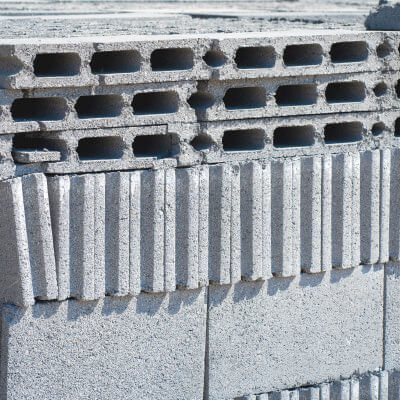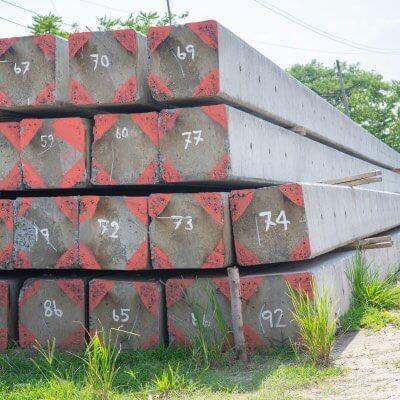El hormigón varía según su preparación y además cumple muchas funciones, siendo un material indispensable en la construcción. Como forma de profundizar en dicho tema, en este artículo vas a descubrir los tipos de hormigón más comunes.
Concrete type: Mass concrete
It’s the concrete that gets poured directly into ready-made moulds.
El hormigón en masa se refiere siempre a volúmenes grandes de hormigón, y que debido a ese gran volumen pueden tener problemas por agrietamiento.
Commonly, mass concrete structures have dimensions larger than 3 meters, amongst them we can mention large foundation slabs and dams.
This large volume of concrete requires measures to minimize cracking, which is caused by thermal reaction within the internal part of the concrete, which can generate a lot of heat due to the hydration process of the cement, and the external part that may be cooling.
Influencing factors during this thermal variation are: the volume of the structure, the ambient temperature, the initial temperature of the concrete at the time of its pour. The type of cement, the content of the mixture and the curing program are also influential.

As a historical anecdote, engineers Ricardo Bellsolá and Bayo used hydraulic (mass) concrete in 1862 for the first time in Spain.
In the public works magazine of 1862, it is documented that this intervention with mass concrete took place in the construction of a bridge over the Tregua river, near the town of Villanueva de Cameros (La Rioja).This bridge had a span of 22 meters, but interest laid in an adjacent work of 3 meter-span and 4.5 meters high that was executed in a monolithic way, that is, made all in one piece by using hydraulic mass concrete.
Types of concrete: Cyclopean concrete
This type of concrete is a mixture of simple concrete and large size stones.
The most correct elaboration of cyclopean concrete would be made up of 60% simple concrete and 40% of stones.

These stones must be washed before being placed into the mixture, and each one of them must be surrounded by cement.
This indicates that in this type of concrete there must be a certain distance between the stones and that this distance must be filled with concrete.
Aunque es un elemento estructural que resiste esfuerzos de compresión por el peso de por si que tiene la estructura, este es un tipo de hormigón que ha quedado en desuso.
En el pasado era muy utilizado para construcciones con cargas poco importantes o para vallas de cerramiento.
Aquí tienes un artículo más completo sobre el hormigón ciclópeo.
Tipos de hormigón: Hormigón celular
El tipo de hormigón celular, llamado también hormigón ligero es un un concreto de baja densidad y elevado aislamiento térmico.
It’s recommended for constructions that require the least amount of weight possible as long as its mechanical performance is maintained.

El hormigón ligero está formado por agua, cemento, partículas de poliestireno y aditivos.
Algunos de los principales usos dado al hormigón celular son:
- Sandwich panel roofs.
- Repairs and restorations with screeds, vault fillings, leveling for wooden floors, etc…
- Leveling concrete between floors.
- Insulating cladding by using formwork on vertical surfaces in prefabricated houses.
- As thermal insulation and anti-humidity screeds to go over the ground.
- Thermo-acoustic insulation and slope formation on flat roofs.
- Repairs and restorations with screeds, vault fillings, leveling for wooden floors, etc…
- Repair and restoration of roofs and terraces in poor condition.
The following is a summary of the materials used to make lightweight concrete.
Unprocessed natural light aggregates:
- Pozzolan
- Travertines
- Lapilli
- Volcanic tuffs
Processed natural light aggregates:
- Expanded clay
- Expanded glass
- Vermiculite
- Expanded perlite
- Synthetic shale
- Expanded shale
Unprocessed light industrial aggregates:
- Blast furnace slag
- Pulverised fuel ash
Processed light industrial aggregates:
- Expanded slag
- Slag foam
- Expanded ashes
- Synthetic ashes
- Plastic particles
- Cereal husk
- Cellulosic shavings
- Porexpa
There are recommendations regarding the use of this concrete, such as pre-moistening the support’s surface, so it doesn’t take the moisture from the mixture.
Another recommendation would be to place rocks manually and carefully to avoid misplacing them and not damaging the adjacent structures.
También sería necesario extender la masa uniformemente y evitar la desecación prematura sería vital para asegurar un buen curado del hormigón.
Debido a su pequeña densidad, este tipo de hormigón ligero, puede ser clavado o aserrado.
También permite obtener piezas grandes y aligerar estructuras.
Elements that don’t require great strength can be built with a lightweight concrete, such as partitions, floor slabs and fasade cladding.
Types of concrete: Structural concrete
This type of concrete, structural concrete, is the type normally used for any type of structure, it can be either civil construction or buildings.
The main characteristic of structural concrete is to improve structure durability.
Tipos de hormigón: Hormigón armado
Llamado también concreto armado, es la unión del hormigón con un esqueleto metálico de hierro redondo.
It provides higher resistance to compressive, tensile and torsional stresses than if it were applied without the metal skeleton.

This type of concrete is the most used to build bridges, all kinds of buildings, dams, tunnels, culverts, roads, liquid conduits, tanks, retaining walls, footings for walls, columns, and others.
A pesar de ser tan util y de ofrecer tantos beneficios a la hora de construir estructuras más estables, también tiene algún punto negativo, y es su dificultad de poder realizar modificaciones futuras en la estructura, debido a el esqueleto metálico existente.
Características
Some of its main characteristics are:
- Anti-seismic structures are made with reinforced concrete, due to their great weight and volume.
- It has a very high strength-durability ratio.
- High traction tolerance.
- Construction styles with reinforced concrete: skyscrapers, the great Art Deco buildings of New York were achieved thanks to the use of this material.
- It does not need a lot of maintenance and it is also very durable.
- Because they have almost the same expansion coefficient, concrete and steel bond strongly.
Definiciones interesantes de conocer respecto al hormigón armado
Dentro del campo de la construcción del hormigón armado, existen algunas definiciones que sería bueno saber, entre las que tenemos:
- Main or longitudinal reinforcement: this is the one used to absorb the tensile stresses caused on thelower part in beams with combined bending.
- Secondary or transverse reinforcement: it maintains the position of the longitudinal reinforcement when the concrete is still in a fresh state and reduces the length of their curvature.
- Tying rebar: small bar or wire that is responsible for holding toguether and confining the steel bars such as stirrups and ties.
- Distribution bars: they are responsible for maintaining the distance and the correct function of the main bars in concrete slabs.
- Retraction bars: they are those that are installed in the slabs where the flexural reinforcement has only one direction.
- Anchor bars: its a bar with a seismic hook on one end, and another one no less than 90º, these must link peripheral longitudinal bars.
- Seismic hook: it’s a stirrup or tie hook with a 135º bend, which joins the longitudinal skeleton and is projected inwards.
Brief introduction to reinforced concrete historical dates
In 1854, Lambot discovered that by joining concrete with an iron reinforcement, it increased considerably and is how he built the first boat made with these materials.
In 1861 a patent was obtained for the execution of certain construction works with reinforced concrete.
In 1867 a patent was also obtained to build cubes and pipes, reducing the thickness of the structures.
Then in 1875, works of greater importance and magnitude were achieved.
In 1884, the German industry obtained the rights to Monier’s perfected patent to use in their country.
From 1890 onwards, this method of construction became generalised in most construction works.
Si aunque quieres saber más sobre este tipo de hormigón, puedes leerte este otro artículo más completo: hormigón armado.
Types of concrete: Prestressed concrete
.
Patentado por Eugène Freyssinet este tipo de hormigón trata de superar la debilidad natural del hormigón a la tracción.
Se construye de forma industrial, y está formado por hormigón y acero, al que se le ha sometido a esfuerzos de compresión antes de entrar en servicio.

The main goal of this prestressed concrete is to increase its tensile strength, by introducing artificial compression stresses before external loads are applied.
Thanks to this technique, we can achieve a higher structural load capacity, eliminating cracks during all stages. This also ensures an increased durability of the construction.
It also provides faster construction.
Tienes algo más de información aquí: hormigón pretensado.
Acabado de hormigón pulido
El hormigón pulido es un acabado para pavimentos de hormigón. Es decir, es una terminación de los suelos hormigón pero mejorados en gran medida.
Polished concrete polishes and smooths the surface and helps prevent cracking , moisture problems, and offers a much harder and more resistant floor that allows the circulation of heavy machinery, spillage of liquids, and promises easy and economic maintenance whilst forgetting about dust problems that are no longer generated with such a finish.
The good thing about polished concrete is that it’s a valid treatment for both new and worn industrial floors.
Floors on wich the polished concrete treatment is carried out on, achieve a new appearance, in addition to the benefits in strength and durability.
In terms of aesthetics, it’s an elegant and shiny finish. It reflects light and homogenizes the entire flooring.
A continuación puedes ver un video explicativo de nuestro tratamiento de pulido y las ventajas que ofrece este acabado.
